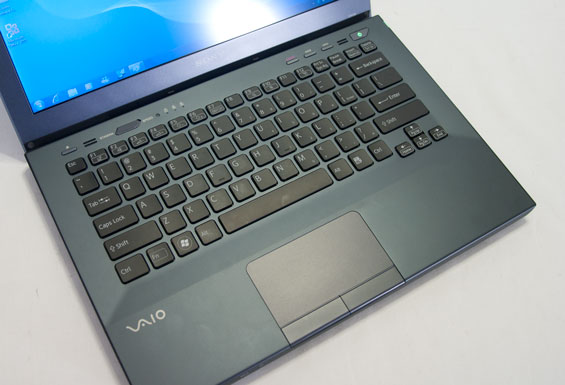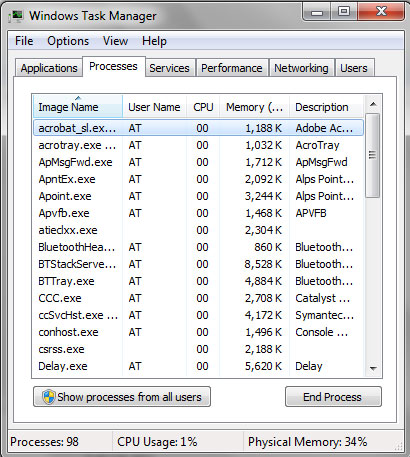Sony VAIO S Series: All Day Consumer Computing
by Dustin Sklavos on September 9, 2011 12:00 AM EST- Posted in
- Laptops
- AMD
- Intel
- Sony
- Sandy Bridge
- 6000M
- VAIO S
- Switchable Graphics
Good Computer, Too Much Bloat
Generally when I've handled these notebook reviews, I haven't gone into the software/bloatware that ships on them too much, if at all. Truth be told, bloatware (at least in my experience) isn't the cancer on the industry that it used to be. These days the worst you have to do is uninstall Norton and disable Bing bar and I'd be hard-pressed to find anyone who thinks that isn't a net win. But before we get to the part where Sony drops the ball with the VAIO S, we'll take a look at the good stuff.
As far as build quality and style go, the VAIO S is primo for a consumer laptop, no doubt about that. Sony uses a combination of aluminum, plastic, and magnesium alloy for the chassis that's extremely attractive, classy, and best of all, functional. There's just no gloss anywhere. And a weight of under four pounds for a powerful 13.3" notebook is really quite good; as far as heft and portability go, it's comparable to a netbook.

The lid appears to be made out of magnesium alloy, as it displays remarkably little flex when you try to twist the screen. From there, the inside surface is brushed aluminum with a recessed, backlit plastic keyboard. My only real complaint as far as the keyboard is concerned is the lack of dedicated document navigation keys, but given the overall thickness (or lack thereof) I'm inclined to let that slide.
Unfortunately the same can't be said for the touchpad. The tracking surface is something that I think is going to divide a lot of end users; some people will really like it, while some people (like me) are just going to find it doesn't feel particularly comfortable to use. Likewise, the mouse buttons feel stiff and require a bit more pressure than I'm used to. The touchpad and buttons probably shouldn't be a dealbreaker for anyone and most users will be able to get used to them, but this is one area where Sony can improve the design of the VAIO S.
Everything else (physically at least) is pretty stellar, though. Above the keyboard is the eject button for the optical drive, next to the "Stamina / Speed" switch. The "Stamina" mode switches off the AMD Radeon HD 6470M and relies on Intel's IGP, while automatically changing the power profile over to "power saver." On the other hand, the "Speed" mode enables the 6470M and switches the power profile over to "high performance." As I mentioned before, Sony appears to be using muxes to handle graphics switching instead of AMD's dynamic switching software solution, and the screen blinks a couple of times (takes about ten seconds) when switching between modes. Thankfully it doesn't require a reboot.
The VAIO S' battery is housed internally, but a single plate on the bottom of the notebook can be removed to swap it out along with changing the hard drive or adding memory to the single DIMM slot. Clearly the battery isn't designed to be hot-swappable, but it doesn't need to be either; there are grooves on the bottom of the notebook the extended sheet style battery latches into.

And then there's this (and then there's Maude?) I actually had my work cut out for me getting the VAIO S into stomping shape for testing, because the factory restored image has a punishing 100 processes running at the outset, which eventually shrinks down to a more reasonable...97? It's really bad. The bloat on the VAIO isn't just the usual bloatware, a tremendous amount of it is Sony's own pack-in crap. Between all of the junk software and the agonizingly slow 5400RPM hard drive, what should be a fairly agile little computer can actually be rendered nigh unusable. I actually had to do the factory restore after I'd started copying over my test suite; Windows Update running in the background was exactly enough to bring the whole system to a crawl, to the point where the mouse pointer lags hopelessly.
Just to put things in perspective: while I'm writing this review on my desktop, I have Photoshop CS5, Windows Live Mail (quiet you), WinAMP, Steam, Trillian, and Firefox open, along with antiviral software, Dropbox, and my UPS system software in the system tray. That brings me up to about 3.6GB of used memory...and 62 processes.
















70 Comments
View All Comments
Brad4 - Friday, September 9, 2011 - link
Thanks for the news update. I also like Sony products, but I'm going to pass on this one. The first thing I scanned for was the display, and I was disappointed to see yet another 16:9 monitor. This would be a nice portable dvd player, but horrible for real productive work.tmensonides - Friday, September 9, 2011 - link
Is there anyone out there now doing differently? I think alienware, hp, dell, lenovo all dropped their 1920*1200 options from their laptop lineups...their might be a few 1440*900 left but i haven't looked.....and certainly not on a 13....I agree though, 16:9 is not great for working....i wonder at the engineers who design these things and then have to actually use them....must be a marketing dept mandate or something
Dustin Sklavos - Friday, September 9, 2011 - link
Honestly, good luck with that. 16:10 is dead. At some point you're just going to have to suck it up, buttercup, and either buy a used 16:10 notebook with outdated hardware, an Apple MacBook Pro for as long as those 16:10 panels last (hint: probably not long), or cope with having ONLY 1600x900 available in a 13.3" form factor, which in my experience is still the highest resolution I've ever seen on a 13" notebook.quillaja - Friday, September 9, 2011 - link
You forgot the 1920x1080 13.3" screen on the Sony Z series. I wish that screen was an option on the S.bennyg - Thursday, September 15, 2011 - link
I would love to see a good hi res screen on a 12/13/14 incher. And a sane one not the Veyron of laptops (Vaio Z) - "spec to the max price bedamned". Can't understand why Asus haven't offered the high-end SKUs of the U36 models with high-res screens.---
Having used both WUXGA and 1080p on my last two 15 inch lappys, aspect doesn't mean anything, screen quality is much more important than 120 vertical pixels.
sferrin - Saturday, September 10, 2011 - link
The OP has a point and it's not so much the resolution as it is the ratio. I have a 790Z with the 1600 x 900 screen and it's a pain in the ass for some work as it's like looking through a slot. I hadn't really noticed how bad it was until I had my dinosaur Sony Z1 with a 1400 x 1050 screen out at it felt like I had a TON more space. I love that thing (if it had updated guts and say a 2000 x 1500 display, or even 1600 x 1200 I'd prefer it over my 790z for everyday stuff).seapeople - Wednesday, September 14, 2011 - link
Honestly I would prefer the 1600x900 over a 1400x1050 if I'm using just one screen. With 1600x900 you can actually put more than one thing on the screen side by side, while with the 1400x1050 you're pretty much stuck using just one application (albeit with more vertical space).Ushio01 - Friday, September 9, 2011 - link
Then get the 1600x900 upgrade 100 more vertical pixels than the old 16:10 1280x800 used to offer.retrospooty - Friday, September 9, 2011 - link
"Then get the 1600x900 upgrade 100 more vertical pixels than the old 16:10 1280x800 used to offer. "1600x900 is better than 1280x800, but in the marketplace its really replacing the 1680x1050 res. Still a step down. Especially vertically (particularly)
Ushio01 - Friday, September 9, 2011 - link
Please point me to a 13" laptop that ever had a 1680x1050 display?If you mean desktop monitors it's 1920x1080 that are replacing 1680x1050 with IPS screens to boot.